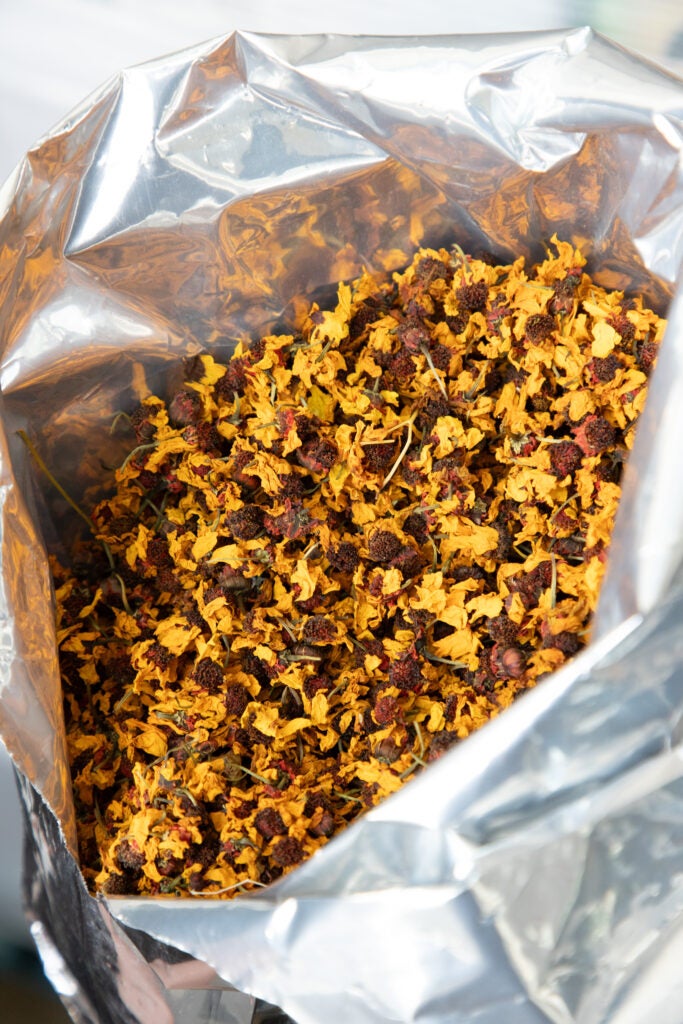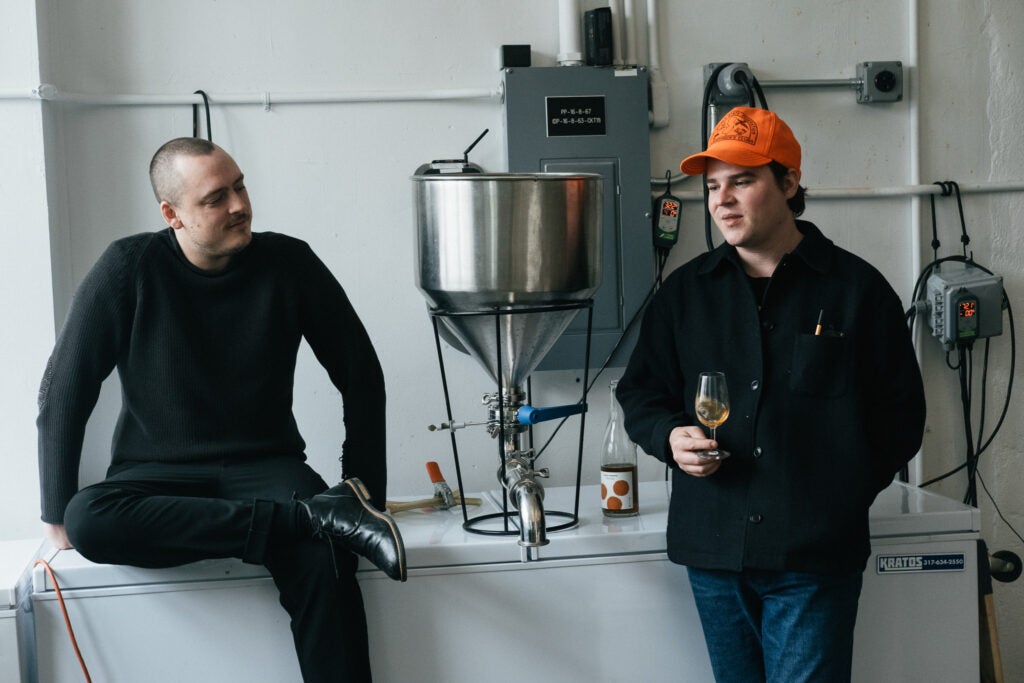The grocery store won’t let you get away with the friendly, carbonated faces of kombucha. A row of rainbows in bottles glows on the refrigerated shelf next to a shot of probiotic soda and inger, promising a hilarious boost in the gut. But for a particular discerning drink head, a mere mention of drinks raises some brows, perhaps due to the reputation of kombucha, which crams flavors and brands that lean a bit violently into the gospel of gut health.
So when young Stowe and Graham’s Parthl began to approach restaurants with samples of snowy chrysanthemums in 2019, kombucha, covered in floral prints brewed with honey and flowers grown beneath Mount Kunlun in China, met skepticism. “We taste it with the bar manager who said, ‘Chefs don’t like kombucha’,” Stowe recalls his first pushback.
This pushback was of little use to stop them. Defying the convention by placing Kombucha’s basic material Tea, the duo continues to refine, making it clear that there is still space in the ignorant non-alcoholic market. In January 2020, they launched Uniform fermentationthe Brooklyn-based fermentation company features Snow Chrysanthemum as its first release. Their single origin lineup was then expanded to Jasmine Green, Nilgiri Green, and Wen Shanbaozon.
“It’s kind of easy to put something as complex and beautiful as tea in a bottle,” Stowe recalls the idea. “Why is no one doing this?”
Uniform fermentation
Today, their drinks, poured into stems in refined bottles of wine, appear on some of the nation’s most respected drink lists, whether they are from Eleven Madison Park in New York and The Four Horseman in Brooklyn to Kato in Los Angeles.
They are not alone either. Nationwide and abroad, new generations of brewers want to throw away the old image of kombucha as a health tonic spiked with raspberry lemonade and cola flavors. Instead, they bring kombucha closer to the world of terroir-driven drinks. This starts with teas where sourcing is just as important as flavor.
Most easily, kombucha requires three basic ingredients: water, sugar and tea. Fermentation begins when a gelatinous disc known as SCOPY, a symbiotic culture of bacteria and yeast, gently converts the sweet liquid into carbonated brewing. (Scoby can be obtained from another kombucha brewer, or it can form naturally when it is not pasteurized.
Tea has been cultivated and celebrated for thousands of years, as we know it, but decades ago Hong Kong is seasoned. The exact origin of kombucha is vague, but some scholars I guess It dates back to 221 BC in Manchuria. It has since evolved into a drink known as Japanese k-stone or black tea mushrooms. Korean golden tea. Russian Cheney Hryv, or tea mushrooms. Living Foods at GT, one of the first commercial kombucha breweries to open in Southern California in 1995, just a few decades ago. It was then supported by denim-wearing hipsters and health-conscious marketing in the 2010s, GT, health status, and commercial brands such as Kevita, owned by PepsiCo.
As kombucha’s popularity grew, there was also the opportunity to rethink mass market drinks and inform people of its potential flavour. Located in Troy, New York, five hours north of Brooklyn Yes fork Tea has now become a destination for such kombucha. Since opening in 2017, founders Yiyi Mendoza and Adam Elabd are tea-obsessed couples who met while studying herbalist, and have focused as much on education as they were producing. To them Tasting RoomOn-draft kombucha flows along with vintage bottles aged in oak barrels. Several alcoholic versions are made in collaboration with local breweries. Meanwhile, the core line with vibrant labels of 12 ounce cans decorate the aisles of gourmet grocery stores and coffee shops in the area.
“Usually it’s cider, coffee, beer, it’s all about sauce ingredients,” Mendoza says. “On the other hand, tea is rarely seen in kombucha.” The Jesus Fork single origin series, featuring brewings such as bamboo oolong, Japanese sencha and yapon (the only caffeinated plant in North America), aims to change that. “What you can make your tea shine is really cutting back on it,” she adds. “The nature of tea is something you come across.”

Unified fermented chrysanthemum tea
The restaurant is catching up too. In Boston, Tracy Chang, chef owner of a Japanese tapas restaurant in Spain Pugnever fell because of the acidified saccharin taste of kombucha. However, after fermenting teas such as Genmaicha and Yunnan black tea and being surprised by the complexity of the resulting drink, she felt she had a tendency to continue experimenting. “I liked how sparkling tea could be complicated with five or six ingredients or kept really simple.”
Today she will reveal her hot discoveries to the public fineMonthly workshops at a restaurant dedicated to non-alcoholic drinks. (As a fermented drink, kombucha legally maintains non-alcoholicity as it contains trace amounts of alcohol, usually below 0.5% ABV.) So she assembles sparkling tea as a serious drink worth pairing with restaurant food, and uses it to spark deeper discussions about global tea sources. “The third wave is behind for tea,” she says. “People are asking: how do people source it? What classifies tea against Tisan? Where does shining tea fit?”
At Kato in Los Angeles, bird director Austin Hennelly likewise had his first hesitation about kombucha. However, when he tried out the unified fermentation and its effermented fermented tea, he knew it would naturally fit into the restaurant’s drink program. “More and more guests want alcohol-free drinks when they go out,” he says. “If restaurants and bars don’t have time to concentrate on alcohol-free cocktail programs, but still want to offer options, it’s a great way to achieve that.”
Creating a tee forward kombucha presents your own challenges. First of all, there are thousands of tea cultivars all over the world, but not all varieties lead to attractive combinations, even the most respected. “Most tea doesn’t actually work,” admits Stowe. “Not all want acidification, fermentation, or carbonation.”

Graham Pertre and the young stowe in unity
Check out Dahon Pao, one of the most expensive and famous oolongs from Fujian Province. That alone produces a complicated, slightly sweet, remaining aftertaste. However, once fermented, the notes tend to collide instead of harmony. Conversely, more routine varieties like Wen Shanba Ozone, a lightly oxidized, mellow oolong tea commonly consumed in Taiwan, grow out and bloom in nets of orchid and watermelon notes upon fermentation.
As far as microbial research in this field is concerned, kombucha is still in its early stages. Harvard PhD student Karo Polo and Basque Cooking Center the study Microbiology and kombucha “the wine and beer industry is very powerful because it invested a lot of money in research,” says Polo. “But that didn’t happen in kombucha. It was a drink that some people in Arizona drank and tasted like, “Oh, this is magic.” ”
in Ama Brewery In the Basque country where Polo conducts graduate studies, Kombucha is undergoing transformation again. From the beginning, Ama co-founders Ramon Perisé and Dani Lasa preferred the label “Pét-Nat Teas.”“A term borrowing language from the natural wine world. “Forget the label “kombucha,” says Polo.
Back in Brooklyn, Stowe feels he can no longer be seen in the kombucha rules. Like AMA, Unified Ferments is moving away from product labeling as Kombucha. Instead, Stowe prefers the term “fermented tea.” This is a subtle but critical swap that shows both respect for the basic ingredients and respect from a sweet commercial taste like kombucha croy. “The industry hasn’t come up with good conditions for these new things,” Stowe says. “We’re always fighting the conditions of the Booze industry.”
Recently, the team continues to strengthen production and interact with new collaborators (and recently, along with Japanese tea suppliers. kettle), expands the vision of fermented tea to accommodate kombucha lovers and skeptics, not just as a substitute for soda, but also as a serious and festive drink in itself.
“We love it when people say, ‘I hate kombucha, but this doesn’t taste good,'” says Stowe. “Well, we didn’t want that.”


